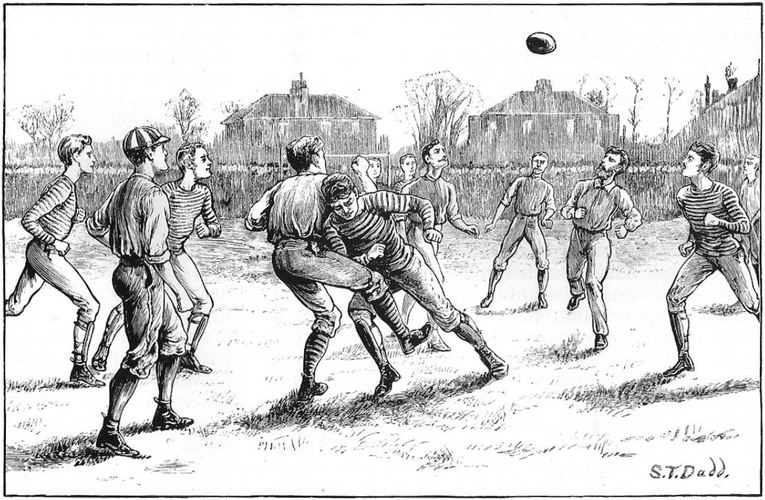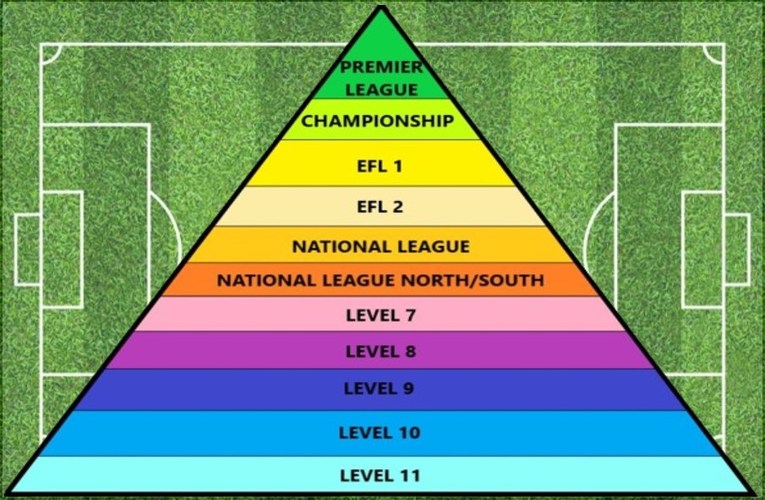 England is the home of football, inventing the sport before seeing it spread around the rest of the world. Nowadays, the Premier League is considered to be the finest league on the planet, if for no other reason than it is also one of the richest and is therefore capable of attracting the best players.
England is the home of football, inventing the sport before seeing it spread around the rest of the world. Nowadays, the Premier League is considered to be the finest league on the planet, if for no other reason than it is also one of the richest and is therefore capable of attracting the best players.
The Premier League sits at the very top of the football pyramid, which is also referred to as the football league system. This series of inter-connected leagues in the world of men’s association football brings together teams from numerous countries in the United Kingdom.
Whilst predominantly for teams based in England, there have been sides from the likes of Wales, Jersey, the Isle of Man and Guernsey that have competed in it over the years. It works as a hierarchical format, seeing teams promoted and relegated between the various leagues depending on their performances each season.
It is impossible to say the exact number of clubs in the football pyramid, on account of the fact that many fold or leave it each year. What we can do, though, is take a look at how it works in general and why it is so important to the game.
The History of the Pyramid

The earliest reference to any sort of football in England actually dates back to 1314, which is when the Lord Mayor of London at the time, Nicholas de Farndone, issued a decree on behalf of the king. It was written in Norman French and declared that anyone playing football could be sent to prison. There is also mention of a version of the sport being played at Cambridge University in 1710. Mostly, though, the game that we understand as football nowadays emerged out of the folk football that was played in the 18th and 19th centuries. Those games bear almost no relation to the sport that is played today.
Football became increasingly popular in public schools during the 19th century, believed to be ‘character building’. Its popularity was especially the case in Rugby School, which ended up taking the sport in one direction when association football was formed, whilst other schools took it in a different one. The Cambridge University Rules were written in 1848 in an attempt to normalise rules that were different depending on where the game was being played. Other areas created their own rules, with Sheffield Football Club being formed in 1857 and writing rules of their own.
As the 19th century drew on, numerous different football leagues were formed in England, with the Football League and the Football Alliance boasting professional pretensions. They were merged in 1892, creating a two-tier competition and forming the beginning of football pyramid in England. Because teams in the south were generally against the idea of professionalism, the leagues were mostly weighted towards teams from the north and the midlands. In 1894, however, the Southern League was formed, made up of both professionals and amateurs.
Still the concerns over professionalism rumbled on, with the Amateur Football Association being formed in 1907, the same year that the Professional Footballers’ Association is created. In 1920, the top division of the Southern League was absorbed into the Football League to create the Third Division. It was quickly split into the Third Division South and the Third Division North, allowing the Football League itself to be expanded to include 92 clubs. In 1958, a new national Third Division is created when the North and South are merged, leaving room for the creation of the Fourth Division.
How the Pyramid Works

Understanding the history of the football pyramid is one thing, but knowing how it works is something else entirely. That is because the English football pyramid is one of the most extensive in the world, covering every level of football in the country. It was, as you might imagine, the first of its kind in the world. It was pioneered by William McGregor, who is considered to be the founding father of the English Football League when he wanted 12 of the most prominent clubs in the country to come together in a league that played home and away on a season-by-season basis.
At the time of writing, there are 57 different leagues in England that are made up of 84 different divisions. The leagues are broken down into different tiers, based on whether they are professional, semi-professional or amateur. The professional leagues are the Premier League, Championship, League One and League Two, with the National League making up the first of the semi-pro leagues. That is split into two steps, which is the National League and the National League North/South. Step seven on the pyramid is made up of leagues from the four corners of the country.
What adds confusion to things is the fact that there are 11 levels, but five steps of football. As an example, the Combined Counties League Premier Division is level 9, but it is step 5 overall.
Here is how the levels work:
- Level 1 – Premier League
- Level 2 – EFL Championship
- Level 3 – EFL League One
- Level 4 – EFL League Two
- Level 5 / Step 1: National League
- Level 6 / Step 2: National League North – National League South
- Level 7 / Step 3: Northern Premier League Premier Division – Southern League Premier Division Central – Southern League Premier Division South – Isthmian League Premier Division
- Level 8 / Step 4: Northern Premier League Division One East – Northern Premier League Division One West – Northern Premier League Division One Midlands – Southern League Division One Central – Southern League Division One South – Isthmian League Division One North – Isthmian League Division One South Central – Isthmian League Division One East
- Level 9 / Step 5: Combined Counties League Premier Division North – Combined Counties League Premier Division South – Eastern Counties League Premier Division – Essex Senior League – Hellenic League Premier Division – Midland Football League Premier Division – North West Counties League Premier Division – Northern Counties East League Premier Division – Northern League Division One – Southern Combination Football League Premier Division – Southern Counties East League Premier Division – Spartan South Midlands League Premier Division – United Counties League Premier Division North – United Counties League Premier Division South – Wessex League Premier Division – Western League Premier Division
- Level 10 / Step 6: Combined Counties League Division One – Eastern Counties League Division One North – Eastern Counties League Division One South – Hellenic League Division One – Midland Football League Division One – North West Counties League First Division North – North West Counties League First Division South – Northern Counties East League Division One – Northern League Division Two – South West Peninsula League Premier Division East – South West Peninsula League Premier Division West – Southern Combination Football League Division One – Southern Counties East League Division One – Spartan South Midlands League Division One – United Counties League Division One – Wessex League Division One – Western League Division One
- Level 11 / Step 7: Anglian Combination Premier Division – Bedfordshire County Football League Premier Division – Cambridgeshire Football Association County League Premier Division – Central Midlands League North Division – Central Midlands League South Division – Cheshire Football League Premier Division – Dorset Premier League – Essex and Suffolk Border League Premier Division – Essex Olympian League Premier Division – Gloucestershire County League – Hampshire Premier League Senior Division – Hertfordshire Senior County League Premier Division – Humber Premier League Premier Division – Kent County League Premier Division – Leicestershire Senior League Premier Division – Lincolnshire League – Liverpool County Premier League Premier Division – Manchester League Premier Division – Middlesex County Football League Premier Division – Midland Football League Division Two – Northamptonshire Combination Football League Premier Division – Northern Football Alliance Premier Division – Nottinghamshire Senior League Senior Division – Oxfordshire Senior League Premier Division – Peterborough and District Football League Premier Division – Sheffield & Hallamshire County Senior Football League Premier Division – Somerset County League Premier Division – South West Peninsula League Division One East – South West Peninsula League Division One West – Southern Combination Football League Division Two – Spartan South Midlands League Division Two – Staffordshire County Senior League Premier Division – Suffolk and Ipswich League Senior Division – Surrey Elite Intermediate Football League Intermediate Division – North Riding Football League Premier Division – Thames Valley Premier Football League Premier Division – Wearside League – West Cheshire League Division One – West Lancashire Football League Premier Division – West Midlands (Regional) League Division One – West Riding County Amateur League Premier Division – West Yorkshire League Premier Division – Wiltshire League Premier Division – York League Premier Division
If that all looks a little messy, that will be because it mostly is.
The steps belong to the semi-professional and amateur levels, which are there effectively as feeder levels through to the professional leagues.
If you’ve ever heard the phrase ‘non-league football’ then this is in reference to any level of the football pyramid that comes below League Two and is therefore not part of the Football League.
Looking at the Levels

Here is a closer look at each of the levels, explaining how they work and the manner in which they interact with the divisions below them:
Premier League – Level 1
Boasting 20 teams, the Premier League see three teams relegated out of it at the end of the season, with the same number of teams being promoted into it from the Championship.
Championship – Level 2
The secondary league in English football is the Championship, which boasts 24 teams. Three of the move up into the Premier League at the end of the season, with the top two doing so automatically and the other making it there from the teams that finish between third and sixth and manage to win a play-off. Three teams are relegated down to League One, with three teams being promoted up to replace them.
League One – Level 3
As with the Championship, there are 24 teams in League One and three of them are promoted out of it at the end of the season. They are made up of the two top teams as well as the play-off winner. Unlike the Championship, however, the bottom four teams are relegated down to League Two.
League Two – Level 4
There are 24 teams in League Two, with four of them being promoted to League One at the end of the season. This is achieved by promoting the top three automatically and seeing the teams that finish between fourth and seventh taking part in the play-offs. Two teams are relegated down to the National League.
National League – Level 5
Boasting 24 teams, two of them get promoted into League Two at the end of the season. The winners go up automatically, whilst the next six teams take part in play-offs for the other space. The bottom four teams, meanwhile, get relegated.
National League North & National League South – Level 6
Once you get into Level 6 of the football pyramid, the leagues are split into two divisions based on the geographical locations of the teams. The divisions run parallel to each other, with 22 teams in each. The winners of the two divisions are promoted into the National League automatically, with the next six teams in the two divisions taking part in play-offs for the other promotion spot. There are eight relegation spaces, which are taken up by the bottom four teams in the two divisions.
Should the promotions and relegations mean that there is an uneven number of teams in the North and South divisions, teams will be moved around based on their geographical location and which ones it makes the most sense to play where.
Northern Premier Division, Southern Premier Division, Southern Premier Central and Isthmian League – Level 7
There are four leagues that run parallel to each other in the seventh level of English football. Each league has 22 teams playing in it, with the champions of each being promoted automatically. The next four of each division take part in play-offs for the second promotion spot that is available for each of the leagues. As with other parts of the football league pyramid, geographical locations will dictate which division a team plays in should the numbers be uneven once promotion and relegation has taken place.
Out of the 88 teams that play at this level, there are 16 teams relegated out of the leagues, with two from each dropping down to Level 8 and going into the league there that is most relevant for them depending on where they’re based.
Level 8
There are obviously far too many leagues that make up Level 8 of the football pyramid. There are eight divisions at the time of writing, with the champions of each being promoted automatically and the next four teams in each of the divisions making it into the play-offs. The five best play-off winners according to points-per-game get promoted. The bottom two teams of each of the divisions get relegated down to Level 9.
Level 9
A total of 16 leagues make up Level 9 of the English football pyramid, eight each feeding either the National League North or the National League South depending on their location. There are a different number of clubs in each, with two promoted and one relegated regardless of whether the league features 18 clubs or 24. They get promoted and relegated into the leagues that are most suitable for them based on the club’s geographical location.
Level 10
At the time of writing, there are nine leagues on the National League North side of Level 10, with eight divisions making up the National League South side. The number of clubs that are relegated out of each or promoted into them varies on a case by case basis. Once again, the geographical location of the teams will dictate the division that they end up in.
Level 11
The final level of the football pyramid is made up of 24 leagues on the Northern side of the pyramid and 25 on the Southern side, as things stand. Again, the exact number of teams that are promoted out of or relegated into them will differ from year to year.
How Teams Enter the Pyramid

Whilst the football pyramid technically only runs to 11 levels, there are as many as 20 levels that make up the overall national structure. As a result, teams can work their way up from the very bottom of the country’s footballing pyramid all the way to the Premier League, although that is obviously extremely unlikely.
There are also criteria in place in order to ensure that teams have suitable facilities to cope with their promotion. As an example, clubs that wish to move from Step 5 to Step 4 have to apply in advance to have their facilities assessed to ensure they make the grade.
In terms of teams within the lower leagues that wish to make it onto the football pyramid in England, they have to make arrangements with the appropriate county feeder leagues in order to be able to do so. It obviously isn’t an easy process to join the pyramid and not all clubs would actually want to do it, such is the extent to which they would face additional financial burdens.
Of course, once a club is in the pyramid they can also get prize money and, depending on the level of the pyramid that they are in, enter competitions such as the FA Cup, which is open to teams in Level 1 to 10.
